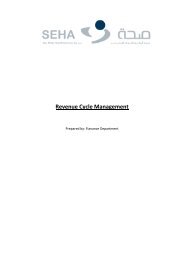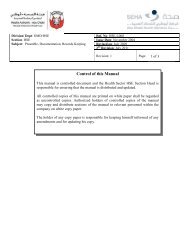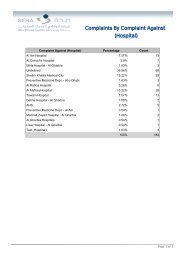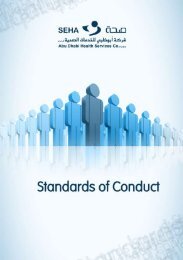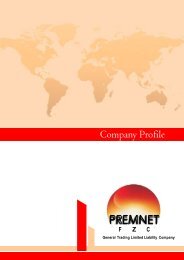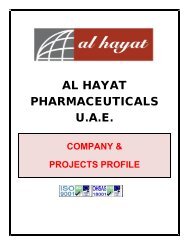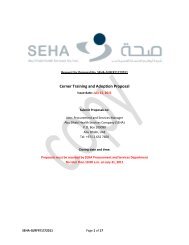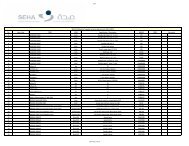The Hospital Risk Assessment Program is designed to ... - SEHA
The Hospital Risk Assessment Program is designed to ... - SEHA
The Hospital Risk Assessment Program is designed to ... - SEHA
You also want an ePaper? Increase the reach of your titles
YUMPU automatically turns print PDFs into web optimized ePapers that Google loves.
Div<strong>is</strong>ion/ Dept: OMD/HSE<br />
Ref. No: HSE-I-012<br />
Section: HSE Issue Date: November 2004<br />
Subject: <strong>R<strong>is</strong>k</strong> <strong>Assessment</strong> <strong>Program</strong> Rev<strong>is</strong>ed on: July 2009<br />
2 nd Rev<strong>is</strong>ion: July 2011<br />
Rev<strong>is</strong>ion: 1 Page: 1of 7<br />
POLICY:<br />
<strong>The</strong> <strong>Hospital</strong> <strong>R<strong>is</strong>k</strong> <strong>Assessment</strong> <strong>Program</strong> <strong>is</strong> <strong>designed</strong> <strong>to</strong> evaluate the impact on patient care as it<br />
relates <strong>to</strong> HSE of the buildings, grounds, internal physical systems and safe practices of hospital<br />
employees.<br />
<strong>The</strong> Performance Improvement Plan for the HSE Committee <strong>is</strong> <strong>designed</strong> <strong>to</strong> moni<strong>to</strong>r the level of<br />
HSE compliance at the hospital, and <strong>to</strong> identify any situations that detract from our goal of<br />
providing a safe and secure environment for our patients, employees, medical staff and v<strong>is</strong>i<strong>to</strong>rs.<br />
Inherent in our moni<strong>to</strong>ring <strong>is</strong> the obligation <strong>to</strong> take corrective action when a problem <strong>is</strong> detected<br />
and <strong>to</strong> provide follow-up <strong>to</strong> corrective actions taken.
Div<strong>is</strong>ion/ Dept: OMD/HSE<br />
Ref. No: HSE-I-012<br />
Section: HSE Issue Date: November 2004<br />
Subject: <strong>R<strong>is</strong>k</strong> <strong>Assessment</strong> <strong>Program</strong> Rev<strong>is</strong>ed on: July 2009<br />
2 nd Rev<strong>is</strong>ion: July 2011<br />
Rev<strong>is</strong>ion: 1 Page: 2of 7<br />
<strong>R<strong>is</strong>k</strong> <strong>Assessment</strong><br />
HAZARD IDENTIFICATION & ASSESSMENT<br />
Define Hazard <strong>Assessment</strong>/Management Systems<br />
<strong>R<strong>is</strong>k</strong> management can only be achieved via management of known and potential hazards and th<strong>is</strong><br />
requires the definition of a Hazard <strong>Assessment</strong>/Management System. <strong>SEHA</strong> / HAAD Facilities<br />
requires have programs and procedures which:<br />
- Identify hazardous activities, the potential hazardous event, and consequences.<br />
- Assess and priorities r<strong>is</strong>ks in cost effective manner.<br />
- Ensure that design of new facilities incorporates HSE r<strong>is</strong>ks.<br />
- Ensure that acqu<strong>is</strong>itions and asset d<strong>is</strong>posal are evaluated for HSE r<strong>is</strong>ks.<br />
- Ensure that HSE hazards from equipment and facility decomm<strong>is</strong>sioning are managed.<br />
It <strong>is</strong> vital that the programs and procedures which are developed and assessed versus r<strong>is</strong>ks, which<br />
are identified and managed. Continuous improvement <strong>is</strong> the key <strong>to</strong> future HSE performance.<br />
With reference <strong>to</strong> figure management of hazards <strong>is</strong> a 4 step closed loop continuous process:<br />
(1)<br />
Identify the<br />
hazard(s)<br />
(2)<br />
Evaluate<br />
Analyse & asses<br />
the r<strong>is</strong>k<br />
(4)<br />
Review & verify<br />
hazards & r<strong>is</strong>ks<br />
(3)<br />
Manage the r<strong>is</strong>k<br />
(<strong>to</strong> acceptable level)
Div<strong>is</strong>ion/ Dept: OMD/HSE<br />
Ref. No: HSE-I-012<br />
Section: HSE Issue Date: November 2004<br />
Subject: <strong>R<strong>is</strong>k</strong> <strong>Assessment</strong> <strong>Program</strong> Rev<strong>is</strong>ed on: July 2009<br />
2 nd Rev<strong>is</strong>ion: July 2011<br />
Rev<strong>is</strong>ion: 1 Page: 3of 7<br />
Procedures<br />
<strong>The</strong> following procedures are <strong>to</strong> be followed when identifying HSE and health hazards, assessing<br />
their r<strong>is</strong>ks and implementing r<strong>is</strong>k control at the <strong>SEHA</strong> / HAAD HCF. Th<strong>is</strong> procedure can be used<br />
<strong>to</strong> prevent hazards from occurring or recurring.<br />
Steps<br />
1. Hazard Identification<br />
2. <strong>R<strong>is</strong>k</strong> <strong>Assessment</strong><br />
3. <strong>R<strong>is</strong>k</strong> Control<br />
4. Ongoing Evaluation<br />
Hazard Identification<br />
Hazard identification <strong>is</strong> the process of identifying hazards in the workplace or for a work<br />
procedure. In order <strong>to</strong> understand what hazard identification involves, it <strong>is</strong> first necessary<br />
understanding the nature of hazards.<br />
Workplace hazards can be divided in<strong>to</strong> six groups;<br />
<br />
<br />
<br />
<br />
<br />
<br />
Physical Hazards such as no<strong>is</strong>e, electricity, heat and cold;<br />
Chemical Hazards such as <strong>to</strong>xic gases, noxious fumes and corrosive liquids;<br />
Ergonomic Hazards such as the height of a workbench, the shape of a vehicle seat and<br />
the length of a control lever;<br />
Radiation Hazards, for example, from x-ray machines, high powered lasers, radioactive<br />
materials;<br />
Psychological Hazards such as stress from using equipment without proper training or<br />
instructions, overwork, or being coerced in<strong>to</strong> using faulty equipment which carries a r<strong>is</strong>k<br />
of injury;<br />
Biological Hazards such as syringes containing potentially infected blood, specimen<br />
containers carrying potentially infected materials and Legionella bacteria and viruses<br />
from air conditioning systems.
Div<strong>is</strong>ion/ Dept: OMD/HSE<br />
Ref. No: HSE-I-012<br />
Section: HSE Issue Date: November 2004<br />
Subject: <strong>R<strong>is</strong>k</strong> <strong>Assessment</strong> <strong>Program</strong> Rev<strong>is</strong>ed on: July 2009<br />
2 nd Rev<strong>is</strong>ion: July 2011<br />
Rev<strong>is</strong>ion: 1 Page: 4of 7<br />
<strong>R<strong>is</strong>k</strong> <strong>Assessment</strong><br />
<strong>R<strong>is</strong>k</strong> assessment <strong>is</strong> the process of assessing all of the r<strong>is</strong>ks associated with each of the hazards<br />
identified during the hazard identification process.<br />
In assessing the r<strong>is</strong>ks, three essential steps are taken:<br />
1. <strong>The</strong> probability or likelihood of an incident of an incident occurring <strong>is</strong> evaluated.<br />
2. <strong>The</strong> severity of the potential consequences <strong>is</strong> calculated or estimated.<br />
3. Based on these two fac<strong>to</strong>rs, the r<strong>is</strong>k are assigned for r<strong>is</strong>k control through the use of a r<strong>is</strong>k<br />
rating.<br />
<strong>R<strong>is</strong>k</strong> assessment involves examining and evaluating the likelihood and severity (or consequence)<br />
of the potential outcomes in order <strong>to</strong> prioritize r<strong>is</strong>ks for control.<br />
Step One – Consequence<br />
What might be the consequence of a hazardous event or situation?<br />
Descrip<strong>to</strong>r<br />
Fatality<br />
Major<br />
Injury<br />
Minor<br />
Injury<br />
First Aid<br />
Negligible<br />
Example Detail Description<br />
Death<br />
Extensive injuries, lost time injury > 5 days,<br />
permanent d<strong>is</strong>ability (e.g. broken bones,<br />
major strains)<br />
Medical treatment required, lost time injury<br />
from 1 – 5 days (e.g. minor strains)<br />
First aid treatment where medical treatment<br />
not required (e.g. minor cuts and burns)<br />
Incident does not require medical treatment,<br />
property damage may have occurred
Div<strong>is</strong>ion/ Dept: OMD/HSE<br />
Ref. No: HSE-I-012<br />
Section: HSE Issue Date: November 2004<br />
Subject: <strong>R<strong>is</strong>k</strong> <strong>Assessment</strong> <strong>Program</strong> Rev<strong>is</strong>ed on: July 2009<br />
2 nd Rev<strong>is</strong>ion: July 2011<br />
Rev<strong>is</strong>ion: 1 Page: 5of 7<br />
Step Two – Likelihood<br />
How likely <strong>is</strong> it that a hazardous event or situation will occur?<br />
Descrip<strong>to</strong>r<br />
Very Likely<br />
Likely<br />
Possible<br />
Unlikely<br />
Highly<br />
Unlikely<br />
Description<br />
It <strong>is</strong> expected <strong>to</strong> occur at some time in the<br />
near future (daily)<br />
Will probably occur in most circumstances<br />
(weekly)<br />
Might occur at some time (monthly)<br />
Could occur at some time (six months <strong>to</strong> a<br />
year)<br />
May occur in exceptional circumstances<br />
(five years plus)<br />
Step Three – <strong>R<strong>is</strong>k</strong> Table<br />
Calculate the degree of r<strong>is</strong>k from the r<strong>is</strong>k table.<br />
Likelihood<br />
Negligible<br />
Injury<br />
Consequences<br />
Minor<br />
Injury<br />
First<br />
Aid<br />
Injury<br />
Major<br />
Injury<br />
Fatality<br />
Very Likely H H E E E<br />
Likely M H H E E<br />
Possible L M H E E<br />
Unlikely L L M H E<br />
Highly<br />
Unlikely<br />
L L M H H
Div<strong>is</strong>ion/ Dept: OMD/HSE<br />
Ref. No: HSE-I-012<br />
Section: HSE Issue Date: November 2004<br />
Subject: <strong>R<strong>is</strong>k</strong> <strong>Assessment</strong> <strong>Program</strong> Rev<strong>is</strong>ed on: July 2009<br />
2 nd Rev<strong>is</strong>ion: July 2011<br />
Rev<strong>is</strong>ion: 1 Page: 6of 7<br />
Step Four – <strong>R<strong>is</strong>k</strong> <strong>Assessment</strong> Outcome<br />
<strong>The</strong> result of the r<strong>is</strong>k matrix <strong>is</strong> compared with the criteria defined below and the required control<br />
strategies are implemented as outlined in the <strong>R<strong>is</strong>k</strong> Control section below.<br />
E: extreme r<strong>is</strong>k: immediate action required; notify superv<strong>is</strong>or, Head of School and the HSE and<br />
Health. If possible, the activity should be ceased immediately.<br />
H: high r<strong>is</strong>k: notify superv<strong>is</strong>or and HSE and health representative and implement immediate<br />
action <strong>to</strong> minimize injury.<br />
M: moderate r<strong>is</strong>k: implement immediate action <strong>to</strong> minimize injury e.g. signs; superv<strong>is</strong>or<br />
remedial action required within five working days.<br />
<strong>R<strong>is</strong>k</strong> Control<br />
<strong>R<strong>is</strong>k</strong> control provides a means by which r<strong>is</strong>ks can be systematically evaluated against a set of<br />
control options (the hierarchy of controls) <strong>to</strong> determine the most effective control method(s) for<br />
the r<strong>is</strong>k(s) associated with each hazard. Th<strong>is</strong> process involves analyzing the data collected during<br />
the hazard identification and r<strong>is</strong>k assessment processes, and developing a strategic plan <strong>to</strong> control<br />
the r<strong>is</strong>ks identified.<br />
<strong>The</strong> r<strong>is</strong>k control process starts by considering the highest ranked r<strong>is</strong>ks, working down <strong>to</strong> the least<br />
significant. Each r<strong>is</strong>k should be examined having regard <strong>to</strong> the "hierarchy of controls". Th<strong>is</strong><br />
provides a method of systematically evaluating each r<strong>is</strong>k <strong>to</strong> determine, firstly, if the causal<br />
hazard can be eliminated and otherw<strong>is</strong>e, <strong>to</strong> find the most effective control method for each r<strong>is</strong>k.<br />
<strong>The</strong> "Hierarchy of Controls" should be used at all times when implementing controls <strong>to</strong> eliminate<br />
the hazard or reduce the r<strong>is</strong>k of a hazard causing loss at the University.<br />
Hierarchy of Controls<br />
<strong>The</strong> hierarchy of controls <strong>is</strong> as follows:<br />
1. Eliminate the hazard.<br />
2. Substitute with a lesser hazard.<br />
3. Use engineering controls <strong>to</strong> reduce hazard.<br />
4. Admin<strong>is</strong>trative controls such as workplace procedures.<br />
5. Personal Protective Equipment.
Div<strong>is</strong>ion/ Dept: OMD/HSE<br />
Ref. No: HSE-I-012<br />
Section: HSE Issue Date: November 2004<br />
Subject: <strong>R<strong>is</strong>k</strong> <strong>Assessment</strong> <strong>Program</strong> Rev<strong>is</strong>ed on: July 2009<br />
2 nd Rev<strong>is</strong>ion: July 2011<br />
Rev<strong>is</strong>ion: 1 Page: 7of 7<br />
In many cases, it will be necessary <strong>to</strong> use more than one control method. Back-up controls (such<br />
as personal protective equipment and admin<strong>is</strong>trative controls) should only be used as a last resort<br />
or as a support <strong>to</strong> other control measures.<br />
Ongoing Evaluation<br />
Moni<strong>to</strong>ring and review <strong>is</strong> the final stage in the process. It <strong>is</strong> the means by which r<strong>is</strong>k<br />
management <strong>is</strong> kept current and effective, as new hazards and those overlooked in the original<br />
process are identified and controlled.<br />
Moni<strong>to</strong>ring and review involves:<br />
<strong>The</strong> systematic re-implementation of the original OHS program steps of :<br />
o Hazard identification<br />
o <strong>R<strong>is</strong>k</strong> assessment<br />
o <strong>R<strong>is</strong>k</strong> control<br />
Th<strong>is</strong> <strong>is</strong> <strong>to</strong> ensure that the process was undertaken properly and that, in hindsight, the conclusions<br />
were correct<br />
<br />
<br />
<br />
Ongoing moni<strong>to</strong>ring of ex<strong>is</strong>ting r<strong>is</strong>k control measures <strong>to</strong> assess their effectiveness in light<br />
of changes and fluctuations in the workplace.<br />
Collection of data on any new hazards which may have ar<strong>is</strong>en and the formulation of new<br />
control measures.<br />
Reviewing the r<strong>is</strong>k management process <strong>to</strong> ensure that all new hazards identified are<br />
controlled.



